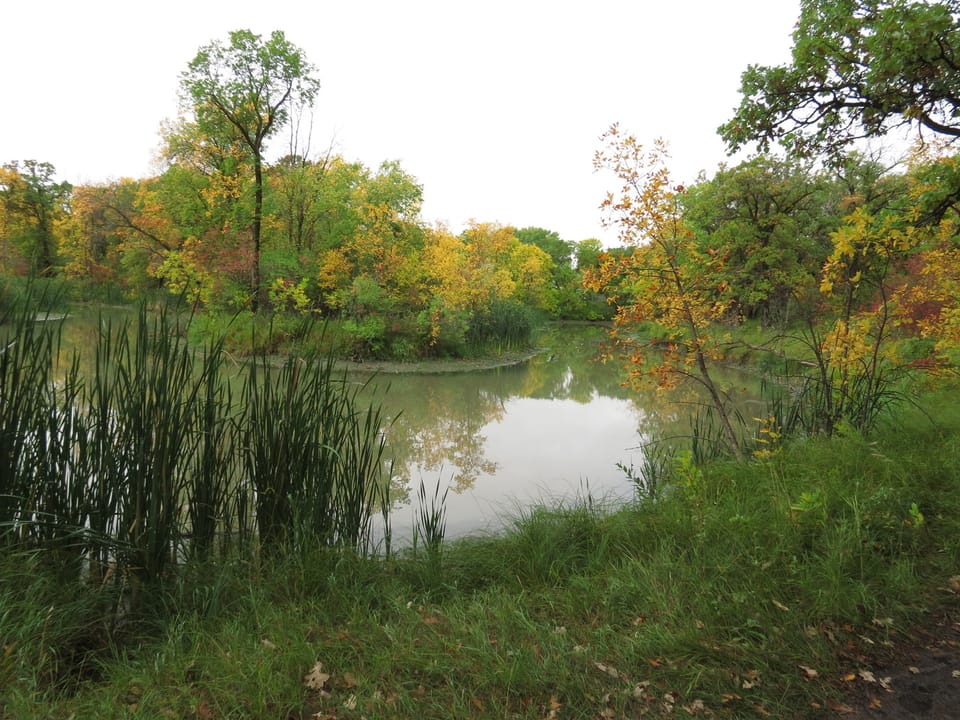Save Our Seine, Winnipeg

The Seine River winds its way through rural Manitoba, approaching Winnipeg from the southeast. It enters the city at the floodway where a significant portion of its flow is diverted, becoming much reduced in size compared to the rural portion. The river continues to flow through St. Vital and St. Boniface before joining up with the Red River. The Seine is never more than waist deep in the urban portion. It’s 20 feet wide in the summer but much wider in the spring when it floods lowland areas.
Louis Riel was born on the banks of the Seine and the city of Winnipeg was founded by people who lived and worked on the river. But, like many urban rivers, it was abandoned, and by the 1980s it was full of garbage. In 1990, a group of local residents, who would become known as Save Our Seine, took matters into their own hands and started removing debris from the river. In 1994, the province of Manitoba established the Green Team funding program, enabling community organizations to hire students to work on summer projects. Save Our Seine, which had been operating informally, incorporated in 1994 and has taken advantage of the grants program every summer to hire a team of young people to clean and enhance the Seine River greenway.
Recreation & Biodiversity
Nowadays, the 26 km section of the river maintained by Save Our Seine is a source of recreation and biodiversity in the midst of a busy, built-up city. There are pathways along sections of the river and it’s popular with paddlers in the spring and early summer. Save Our Seine created Winnipeg’s first ever accessible canoe launch in 2020. In winter, some residents clear a walking trail on the river and last year Save Our Seine organized a skiing event with free rental skis. They hope to host more winter activities in future.
The Seine River greenway is home to coyotes and deer as well as a wide range of birds, and paddlers often spot snapping turtles. Save Our Seine is working hard to replace invasive plants such as European buckthorn and purple loosestrife with native varieties. A two-year urban restoration and enhancement project is underway with plans to create a pollinator habitat, plant trees, and establish an educational node in a park by the river. They are working with the Manitoba Métis Foundation to develop a healing forest in the Bois-des-Esprits.
The Bois-des-Esprits forest lies along the Seine River. It’s one of Canada’s largest urban forests but was almost lost to housing developments. Save Our Seine stepped in and, through extensive lobbying and fundraising, was able to save it from destruction. Encompassing wetland, river bottom forest, upland forest, and tallgrass prairie, the forest is home to a wide number of mammals, birds, fish, amphibians and reptiles, as well as over 180 different native plants.
Future Plans
As so much water has been diverted into the floodway, the Seine does not flow naturally. Some years, by the end of summer, the river has dried up with marshy sections disconnected from each other. As a result, fish are confined to small ponds leading to reduced populations, and there is damage to the plant life. Canoeists can no longer navigate the river. Save Our Seine hopes to address these problems by ensuring that more water is released into the river.
A large property of land south of the Perimeter Highway is relatively undisturbed and Save Our Seine hopes to coordinate its purchase in order to establish a natural area similar to Bois-des-Esprits in anticipation of further suburban growth in the area.
Save Our Seine is also a major stakeholder in a community group that hopes to establish a national urban park in north St. Boniface that would incorporate the Red and Seine rivers. The organization is also active in developing strong partnerships with Indigenous peoples and organizations to further reconciliation.
Ryan Palmquist, Save Our Seine’s managing director, is proud that the Seine is now being restored to its rightful place at the heart of Winnipeg’s cultural and historic identity. True to their goal, Save Our Seine is demonstrating that you can have a thriving ecosystem in an urban zone where both humans and wildlife can thrive.
Further Information
Protecting Nose Creek’s Watershed, Wildlife, History & Community Green Space in Calgary [EcoFriendly West]
Bringing New Life to an Urban Stream: Bowker Creek, Victoria [EcoFriendly West]
Photo credit: Save Our Seine Facebook page
EcoFriendly West informs and encourages initiatives that support Western Canada’s natural environment through its online publication and the Nature Companion website/app. Like us on Facebook, follow us on Twitter or Mastodon, or subscribe by email.

Member discussion